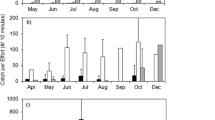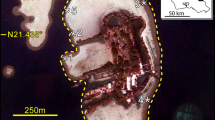Abstract
We examined distribution and habitat use by the dwarf crayfishesCambarellus diminutus andC. shufeldtii in seven coastal drainages along the Mississippi Gulf coast.Cambarellus shufeldtii occupied a wider coastal geographic range thanC. diminutus, with the latter species being restricted to eastern drainages.Cambarellus shufeldtii occurred in sites that were less acidic and had lower relative abundance of emergent aquatic vegetation and more variable relative abundance of submerged aquatic vegatation than sites typically used byC. diminutus. The two species were not syntopic in any collections, although they co-occurred in two of the drainages sampled. Both crayfishes were collected more frequently from oxbow side-ponds than from adjacent channel habitats. Oxbow side-ponds are characterized as less turbid than channels, warm, slow-moving, heavily vegetated, and having a bottom substratum covered with litter compared to adjacent channel habitats. Further, oxbow side-ponds were characterized by structurally complex submerged aquatic vegetation such asMyriophyllum aquaticum andElodea canadensis, which may provide enhanced protection from predators. Dwarf crayfish body size coupled with macrophyte complexity and coverage may explain their disproportionate use of oxbow side-ponds compared to channel habitats. Oxbow side-ponds appear to be important habitats for dwarf crayfish in the coastal drainages in the northern Gulf of Mexico.
Similar content being viewed by others
Literature Cited
Bettoli, P.W., M.J. Maceina, R.L. Noble, and R.K. Betsill. 1992. Piscivory in largemouth bass as a function of aquatic vegetation abundance. North American Journal of Fisheries Management 12: 509–512.
Black, J.B. 1965. A survey of the genusCambarellus in Mississippi (Decapoda, Astacidae). Journal of the Mississippi Academy of Science 11:216–217.
Black, J.B. 1966. Cyclic male reproductive activities in the dwarf crawfishesCambarellus shufeldti (Faxon) andCambarellus puer Hobbs. Transactions of the American Microscopy Society 85:214–232.
Bouchard, R.W. 1978. Taxonomy, distribution, and general ecology of the genera of North American crayfishes. Fisheries 3:11–16.
Burr, B.B. and H.H. Hobbs, Jr. 1984. Additions to the crayfish fauna of Kentucky, with new locality records forCambarellus shufeldtii. Transactions of the Kentucky Academy of Science 45:14–18.
Folk, R.L. 1980. Petrology of Sedimentary Rocks. Hemphill Publishing Co., Austin, TX, USA.
Garvey, J.E., R.A. Stein, and H.M. Thomas. 1994. Assessing how fish predation and inter-specific prey competition influence a crayfish assemblage. Ecology 75:532–547.
Hobbs, H.H., Jr. 1945. Two new species of crayfishes of the genusCambarellus from the Gulf coast states, with a key to the species of the genus (Decapoda, Astacidae). American Midland Naturalist 34:466–474.
Hobbs, H.H., Jr. 1989. An illustrated checklist of the American crayfishes (Decapoda:Astacidae, Cumbaridae, and Parastacidae). Smithsonian Contributions in Zoology 480:1–236.
Lillie, R.A. and J. Budd. 1992. Habitat architecture ofMyriophyllum spicatum L. as an index to habitat quality for fish and macroinvertebrates. Journal of Freshwater Ecology 7:113–125.
Penn, G.H. 1942. Observations on the biology of the dwarf crawfish,Cambarellus shufeldti (Faxon). American Midland Naturalist 28:644–647.
Penn, G.H. 1950. The genusCambarellus in Louisiana (Decapoda, Astacidae). American Midland Naturalist 44:421–426.
Ross, S.T., J.A. Baker, and K.E. Clark. 1987. Microhabitat partitioning of southeastern stream fishes: temporal and spatial predictability. p. 42–51.In W.J. Matthews and D.C. Heins (eds.) Community and Evolutionary Ecology of North American Stream Fishes, University of Oklahoma Press, Norman, USA.
Stein, R.A. and J.J. Magnuson. 1976. Behavioral response of crayfish to a fish predator. Ecology 57:751–761.
Author information
Authors and Affiliations
Rights and permissions
About this article
Cite this article
Peterson, M.S., Fitzpatrick, J.F. & VanderKooy, S.J. Distribution and habitat use by dwarf crayfishes (Decapoda: Cambaridae:Cambarellus). Wetlands 16, 594–598 (1996). https://doi.org/10.1007/BF03161351
Received:
Revised:
Accepted:
Issue Date:
DOI: https://doi.org/10.1007/BF03161351




